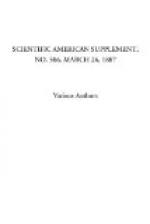[Illustration: The new 1101/2 ton Elswick guns for H.M.S. Benbow.]
The maximum firing charge is 900 lb. of cocoa powder. The projectile weighs 1,800 lb. The estimated muzzle velocity is 2,216 ft. per second. The capacity of the chamber is 28,610 cubic inches, and that of the bore 112,595 cubic inches. The estimated total energy is 61,200 ft. tons. It will be a few days probably before the full powers of the gun are tested, but the above are confidently expected to be attained, judging from the results with the 100 ton guns supplied to Italy. On January 7 last we gave those of the new Krupp 119 ton gun. It had fired a projectile with a velocity of almost 1,900 ft. with a charge of less than 864.67 lb., with moderate pressure. The estimated maximum for this gun was a velocity of 2,017 ft. with a projectile weighing 1,632 lb., giving a total energy of 46,061 ft. tons, or 13,000 ft. tons less than the Elswick gun, comparing the estimated results.
The proof of the Elswick gun is mounted on a carriage turned out by the Royal Carriage Department, under Colonel Close. This carriage is made on bogies so as to run on rails passing easily round curves of 50 ft. radius. The gun is fired on an inclined length of rails, the recoil presses of the carriage first receiving the shock and reducing the recoil. The carriage is made to lift into the government barge, so as to go easily to Shoeburyness or elsewhere. It can be altered so as to provide for turning, and it allows the piece to be fired at angles of elevation up to 24 deg. The cheeks of the carriage are made to open and close, so as to take the 12 in. gun and larger pieces. The steel castings for it are supplied from the Stanners Close Steel Works.
[Illustration: Fig. 4.]
The first round was fired at about noon. The charge was only 598 lb., consisting of four charges of 112 lb. and one of 130 lb. of Waltham Abbey brown prism No. 1 powder. The proof shot weighs, like the service projectile, 1,800 lb. Thus fired, the gun recoiled nearly 4 ft. on the press, and the carriage ran back on the rails about 50 ft. The projectile had a velocity of 1,685 ft. per second, and entered about 52 ft. into the butt. We cannot yet give the pressure, but unquestionably it was a low one. The charges as the firing continues will be increased in successive rounds up to the full 900 lb. charge.
Figs. 1 and 2 show the mounting of the 1101/2 ton gun in the barbette towers of the Benbow. The gun is held down on the bed by steel bands and recoils in its bed on the slide (vide Fig. 2). The latter is hinged or pivoted in front and is elevated by elevating ram, shown in Fig. 2. When the slide is fully down, the gun is in the loading position. The ammunition lift brings up the projectile and charge, which latter is subdivided, like those employed in the German guns, in succession to the breech, the hydraulic rammer forcing them home.




